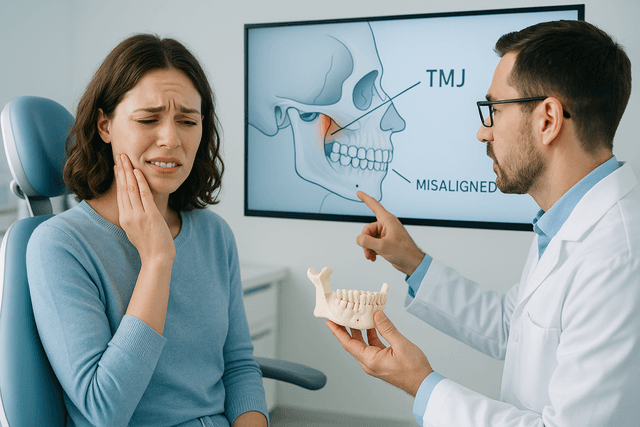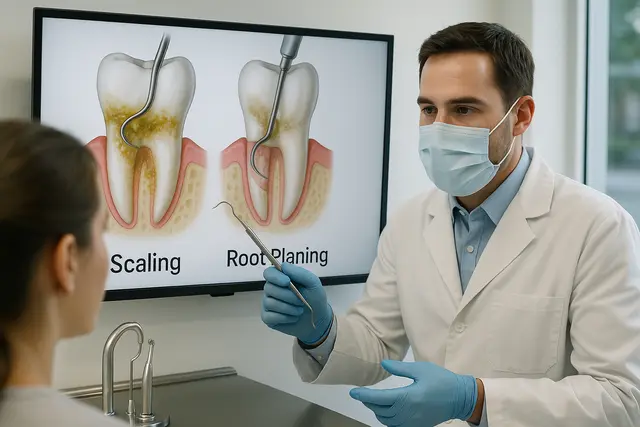General Dentistry
5 min read
Jul 09, 2025
Misaligned Jaw and TMJ: How It Affects Your Smile
If your smile feels a bit off lately, like your bite isn’t quite right or your jaw’s making odd noises, you’re not imagining things. A misaligned jaw or TMJ disorder could be the culprit. These issues do more than mess with your grin; they can affect how you chew, speak, and even how your face looks.

So your smile feels a little... off. Maybe your bite doesn’t line up the way it used to, or you’ve caught yourself wincing while chewing your favorite sandwich. You might even hear a click when you yawn. These aren’t just quirky jaw habits. They could be signs that your jaw is out of alignment, and yes, it can have a pretty big impact on everything from your comfort to your confidence.
Let’s break down how a misaligned jaw affects your smile, how TMJ disorders sneak into the picture, and what you can do about it without gritting your teeth through the pain.
Jaw Misalignment and the Trouble It Brings
Jaw misalignment happens when the upper and lower jaws don’t quite meet the way they should. It’s like trying to shut a drawer that’s slightly off its tracks, annoying at first, but eventually something’s bound to break. Whether it’s a result of missing teeth, bruxism, a crooked growth pattern, or an old injury, misalignment can mess with the way your teeth and jaw work together.
Over time, this puts stress on your jaw muscles, causes difficulty chewing, and may even affect your facial symmetry. The jaw may shift more to one side, creating an asymmetrical face or a crooked smile that wasn’t there before. And because the jaw joint is connected to so many other areas, your temples or jaw, neck, and posture; it’s not just your mouth that feels the effects.
When TMJ Enters the Chat
Here’s where TMJ comes in, short for temporomandibular joint. This little hinge near your ears lets your jaw open, close, talk, chew, and yawn. But when the jaw is misaligned, it can throw this joint out of whack, leading to TMJ disorder, also known as TMD.
TMJ disorder symptoms range from nagging jaw aches to full-on jaw locking, headaches, earaches, popping sounds, and even limited jaw movement. The joint can cause pain that radiates across your face and neck, especially if teeth grinding (aka bruxism) is part of the package. You might not even know if your jaw is misaligned until these symptoms start cropping up.
Crooked Jaw, Crooked Smile
A crooked jaw often translates into misaligned teeth, which can cause your upper and lower teeth to hit awkwardly or not meet at all. If your smile feels uneven or your bite seems lopsided, your jaw alignment could be the culprit.
Beyond appearance, teeth misalignment affects how you chew, speak, and rest your mouth. It can even wear down your teeth unevenly, creating more jaw symptoms over time. And since a misaligned jaw can cause your bite to shift, your facial appearance may subtly change as well, think tilted chin, tight lips, or even a tension-filled expression.
The Everyday Things a Misaligned Jaw Can Cause
A misaligned jaw can cause more than just cosmetic issues. Here are a few uncomfortable realities you might not expect:
Chronic jaw pain or tension headaches from overworked jaw muscles
Clicking, popping, or grinding noises during basic jaw movement
Worn-down enamel from teeth grinding due to improper jaw alignment
Strain when trying to chew tough foods or even open your mouth wide
A tired, sore feeling around the jaw at the end of a long day
If symptoms like these keep popping up, it’s worth getting a professional look, especially if TMD symptoms are interfering with your sleep or daily routines.
Alignment Matters (More Than You Think)
Jaw alignment issues don’t just come out of nowhere. Sometimes the misalignment starts early, like during childhood, especially if habits like thumb sucking or extended pacifier use pushed things around. Other times, it’s the result of missing teeth, trauma, or even slow shifts over the years.
Posture plays a role, too. A slouched neck or tilted head changes the position of the jaw, which can lead to misalignment over time. So yes, your yoga instructor was right: posture matters.
What’s worse is that misalignment can make it challenging for your jaw to function the way it naturally should. The upper and lower jaws don’t work together, which creates tension not just in your mouth, but all over your face and neck. And that’s not ideal for anyone, especially if you like smiling without pain.
Treatment Options That Actually Work
Let’s talk treatment options, because the good news is this: You don’t have to live with a wonky bite forever. Depending on the severity of the misalignment, your dentist or TMJ specialist may recommend:
Orthodontic treatment (like braces or clear aligners) to guide your teeth into proper position
A custom nightguard to reduce grind and protect against teeth grinding
Jaw exercises or physical therapy to strengthen the muscles around the jaw
Dental restorations to fix crooked teeth or fill in for missing teeth
Surgery, in extreme cases, such as jaw wiring or joint correction
In many cases, small shifts and consistent care can realign the jaw gradually. You might not notice instant results, but over time, these treatments help improve jaw alignment and reduce jaw symptoms that come from everyday use.
How to Know If Your Jaw Needs Help
Wondering how to know if your jaw is the issue? Here are a few red flags:
You notice one side of your bite hits first
Your lower teeth don’t line up with your upper teeth
You hear a pop or feel a shift when you open or close your mouth
Chewing feels uncomfortable or takes more effort
You’re experiencing symptoms like headaches, earaches, or tightness in your jaw
If that sounds familiar, it might be time to get checked. A professional exam can examine your teeth, check for malocclusion, and help correct misalignment before it gets worse.
Let’s Bring That Smile Back
We know; this sounds like a lot. But the truth is, your jaw health affects way more than your smile. It plays a major role in how you eat, speak, sleep, and express yourself. If your jaw doesn’t feel right, or your smile’s been looking a little uneven, there’s no shame in getting help.
The sooner you look into treating TMJ disorders or addressing teeth misalignment, the sooner you can fix a misaligned jaw and get back to smiling like yourself again. And hey, that’s worth chewing on.
What Are the Signs That My Jaw Is Misaligned?
Common signs of jaw misalignment include jaw clicking or popping, discomfort while chewing, headaches, facial asymmetry, or a bite that feels off. You may also notice that one side of your bite hits first, your teeth don’t meet evenly, or you experience jaw tension at the end of the day. These symptoms can develop gradually and are often overlooked until they begin to interfere with daily comfort.
How Does a Misaligned Jaw Affect My Smile and Facial Appearance?
A misaligned jaw can change the way your smile looks by shifting your teeth or creating an uneven bite. Over time, this can lead to a crooked smile, worn-down teeth, and even changes in facial symmetry, such as a tilted chin or tighter lips. These subtle shifts not only impact aesthetics but can also affect your self-confidence and how your facial muscles function.
What Role Does TMJ Disorder Play in Jaw Misalignment?
TMJ disorder, or TMD, often develops when jaw misalignment stresses the temporomandibular join, the hinge near your ears that controls jaw movement. This stress can lead to pain, jaw locking, limited motion, and radiating discomfort in the face, neck, or ears. TMD may also be triggered by teeth grinding, missing teeth, or poor jaw posture, making proper alignment essential for long-term joint health.
What Treatment Options Are Available for a Misaligned Jaw?
Treatment depends on the cause and severity of your misalignment. Options include orthodontic treatment like braces or aligners, nightguards to reduce grinding, jaw exercises, physical therapy, and dental restorations to correct missing or damaged teeth. In severe cases, surgery may be recommended. Many patients find relief through non-invasive approaches that gradually improve alignment and reduce painful symptoms.
Read Next
Related Posts

General Dentistry
How to Stop Nerve Pain in Tooth: Fast Relief That Works
Tooth nerve pain can be one of the most intense and disruptive types of discomfort. It often strikes without warning and makes everyday activities like eating, drinking, or even talking feel unbearable. Understanding what causes this pain and how to manage it effectively is key to getting fast relief.
4 min read
Sep 15, 2025

General Dentistry
Can a Sinus Infection Make Your Jaw Hurt? Understanding the Connection
Jaw pain can be unsettling, especially when it seems to appear out of nowhere alongside a stuffy nose or headache. Many people are surprised to learn that sinus infections can cause discomfort that feels like it’s coming from the jaw. Understanding the connection between your sinuses and jaw pain is key to getting the right treatment.
5 min read
Sep 15, 2025

General Dentistry
What Is SRP in Dentistry? A Complete Guide to Scaling and Root Planing
When it comes to dental health, most people think regular cleanings are enough to keep their smile safe. But sometimes, what’s happening below the gumline needs more attention. Scaling and root planing (SRP) is a treatment designed to address gum disease at its source, protecting both your gums and teeth from long-term damage.
5 min read
Sep 10, 2025
Don’t have time to research every dentist around you?
See why 30k+ patients trusted us